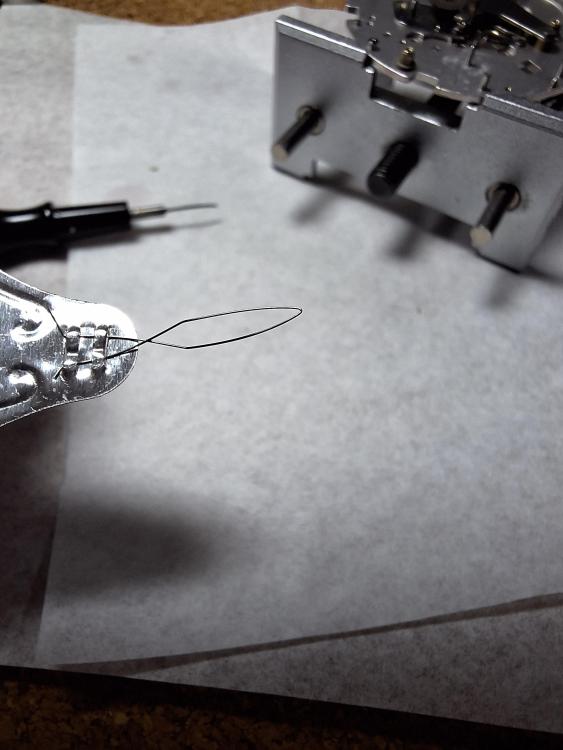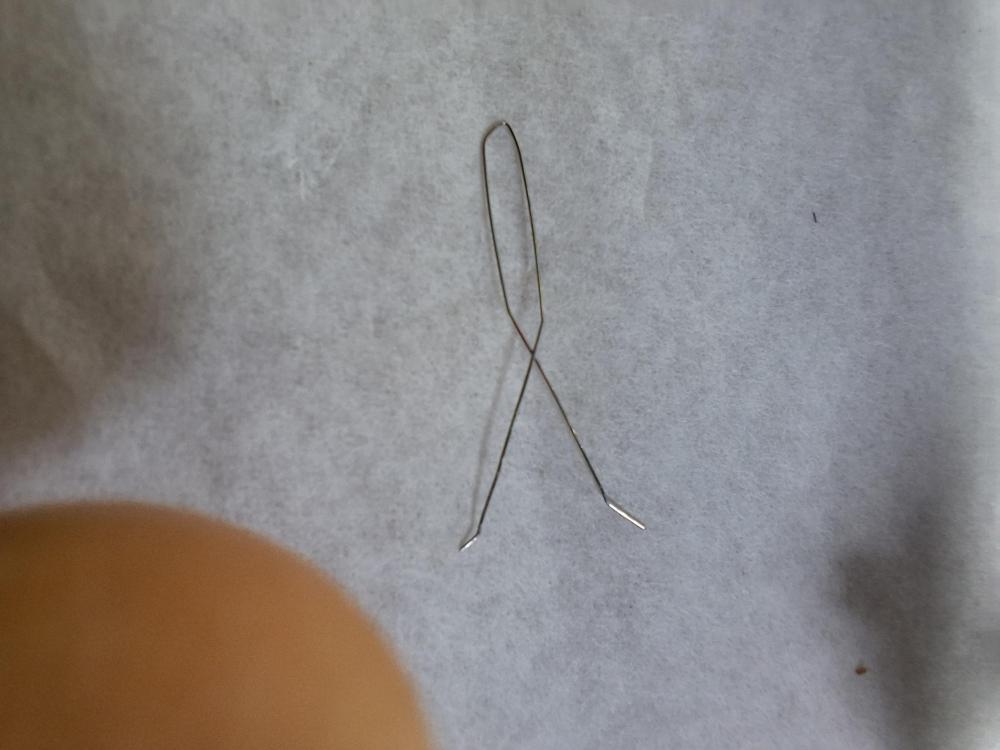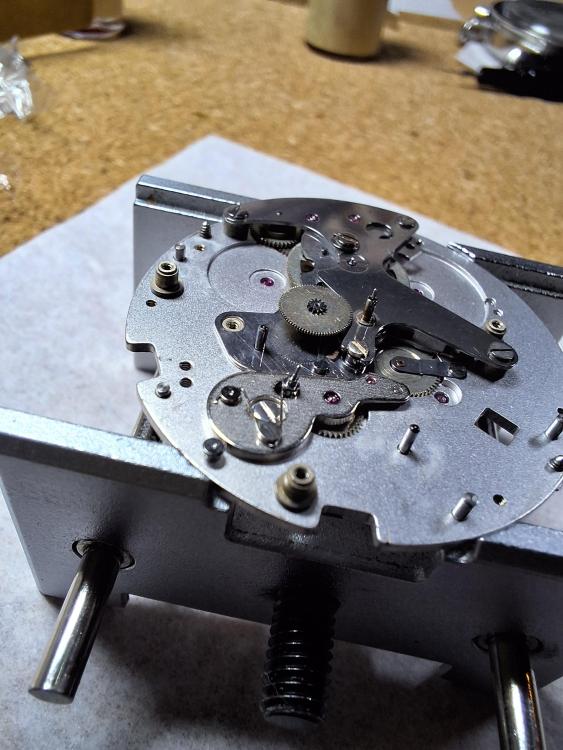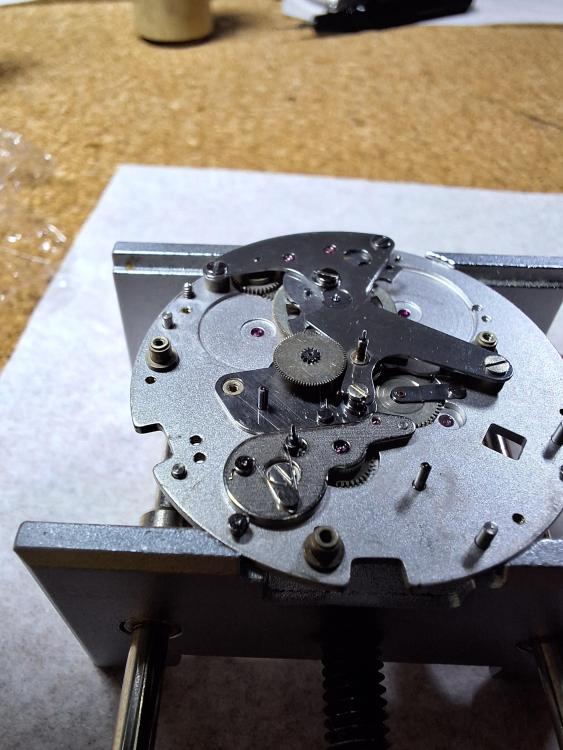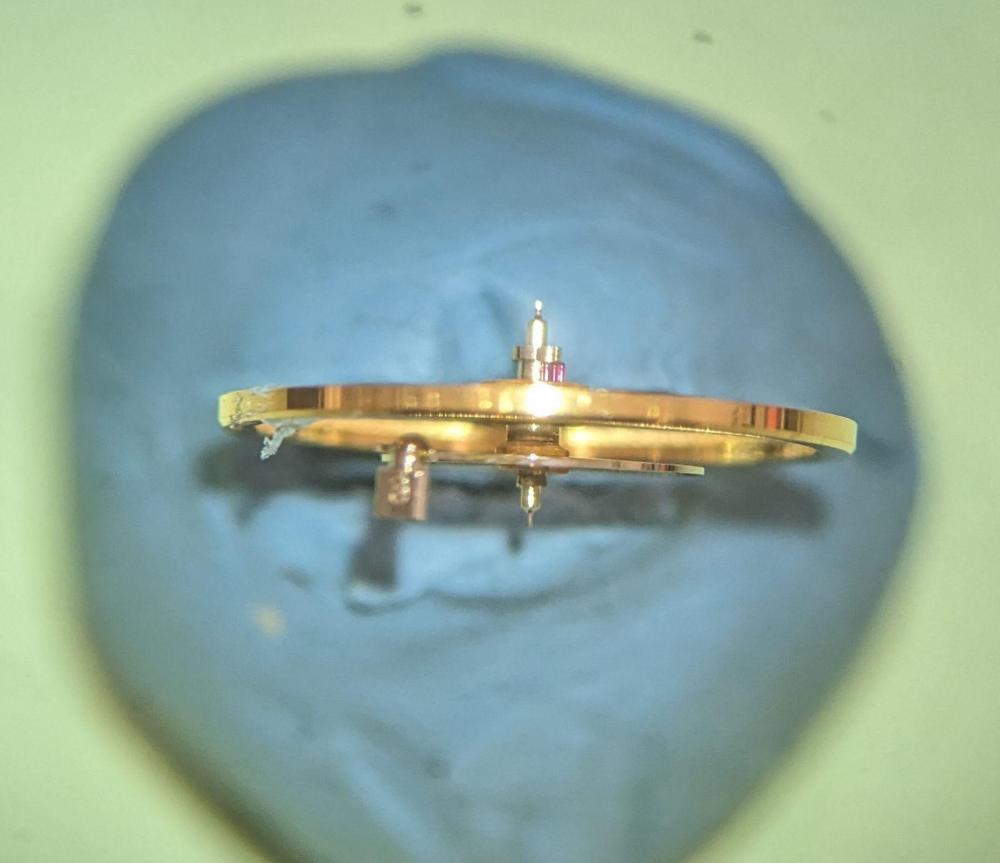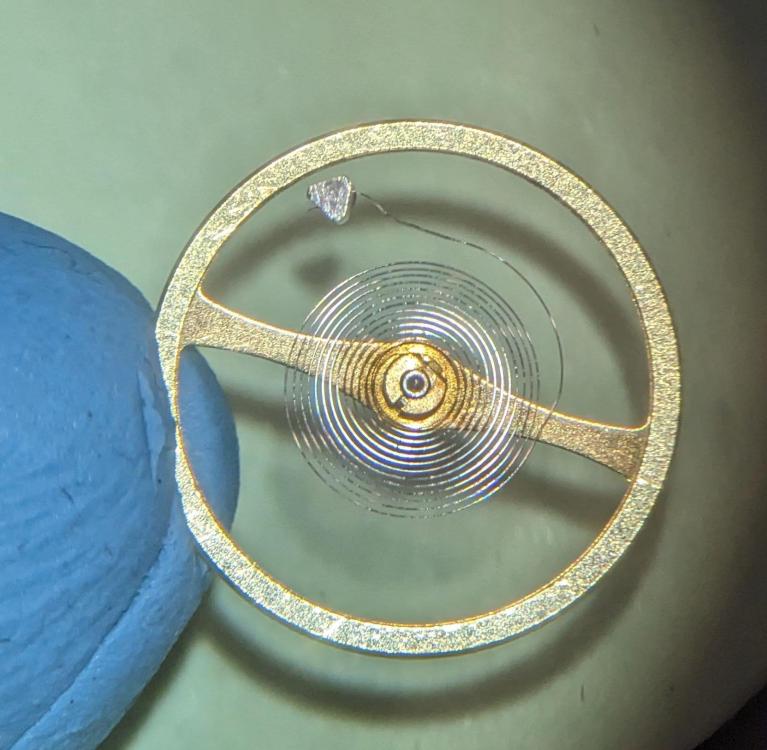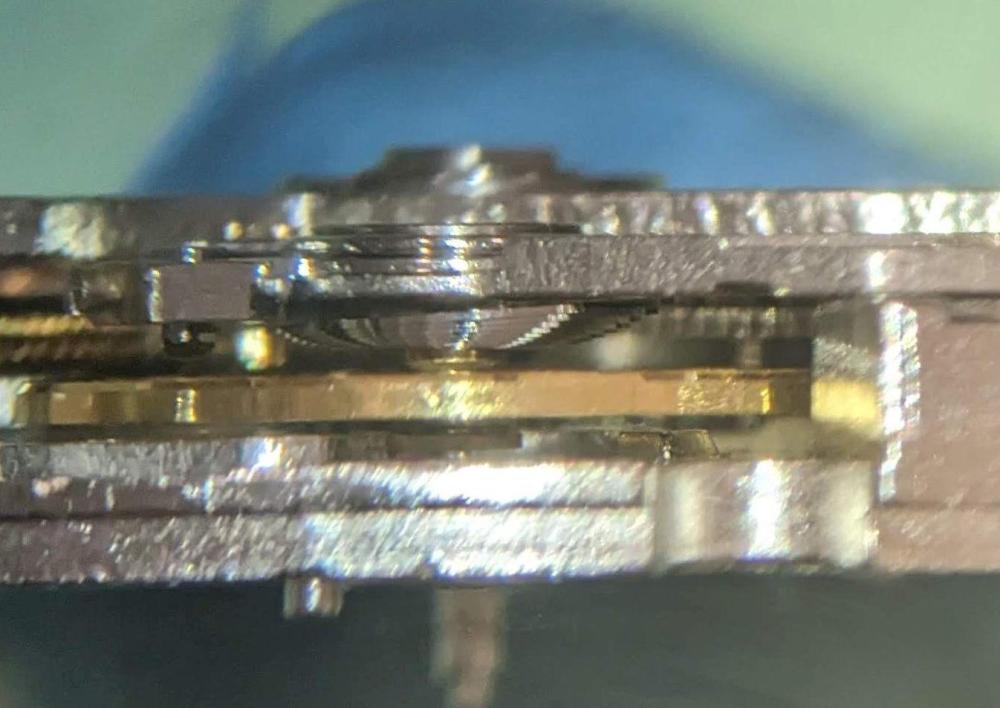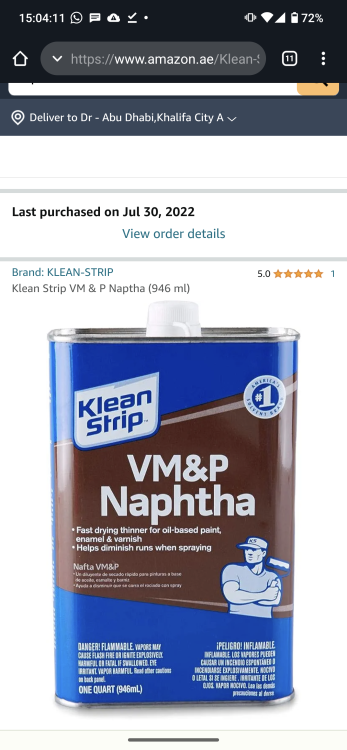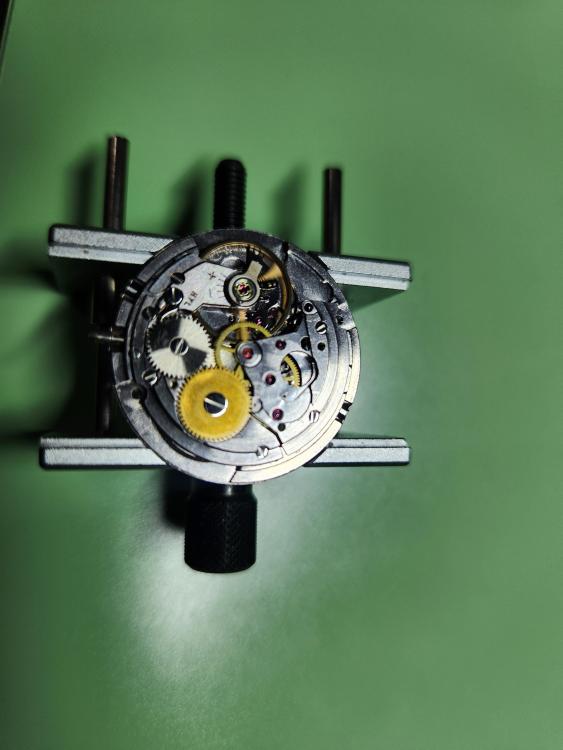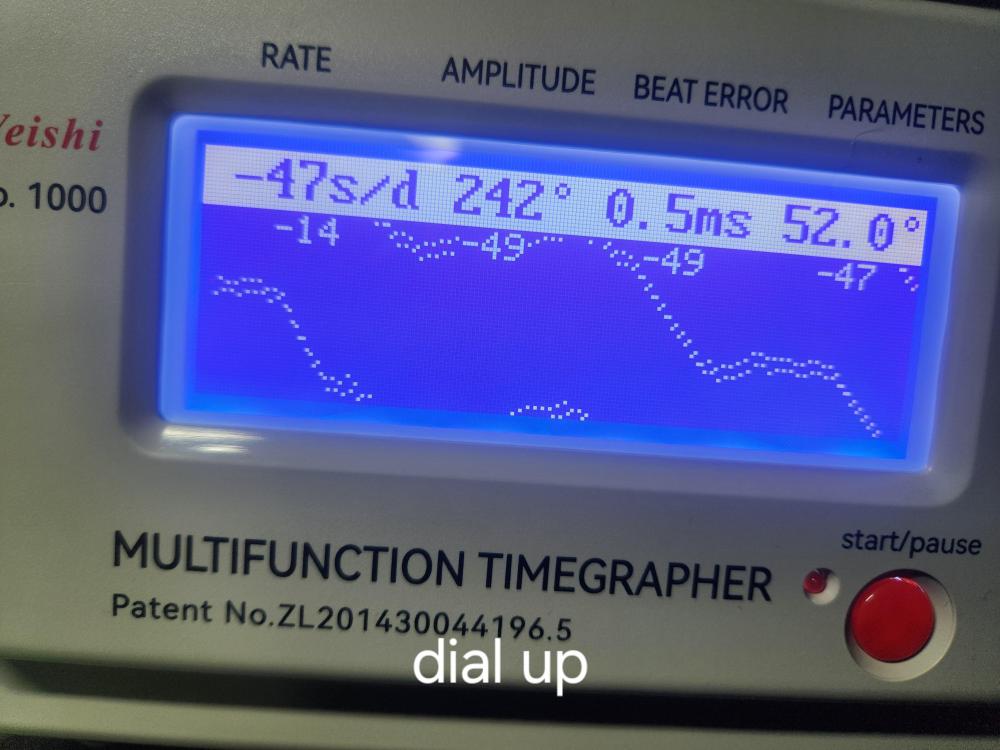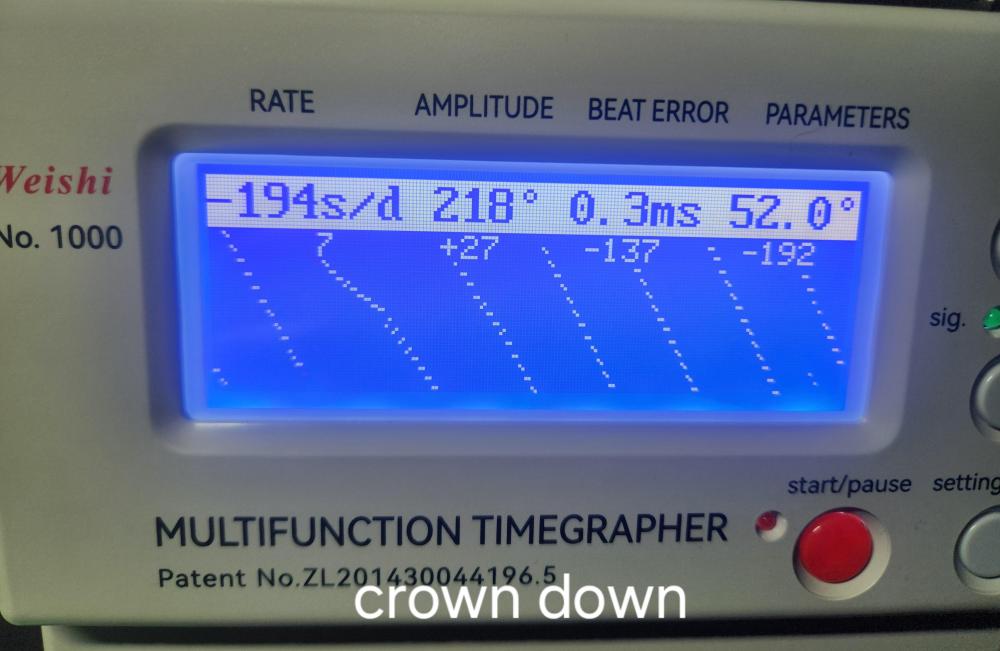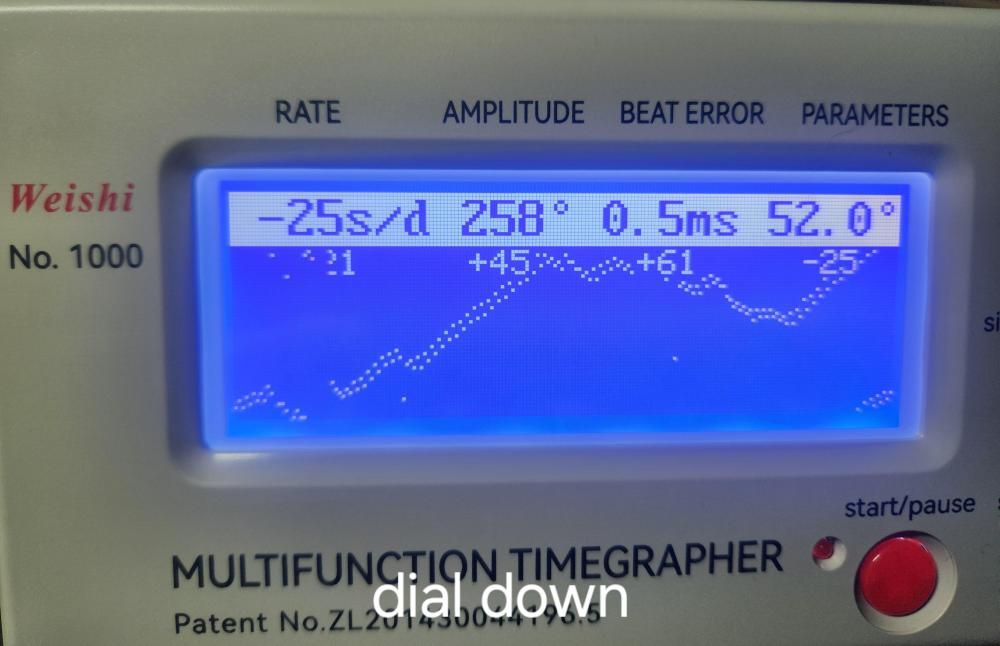Search the Community
Showing results for 'lighter fluid' in topics.
-
Hunt for (a bit) more amplitude - Rolex 2135
nickelsilver replied to Knebo's topic in Fault Finding / Fault Diagnosis
Your oil concentricity on the escape wheel isn't robbing amplitude. Also, I've seen folks eat burgers with fork and knife in Switzerland . Funny, I have a friend who worked for rolex as an instructor, and they actually stipulate (or used to) to: peg jewels, and stick pinions into button pithwood soaked with benzine (lighter fluid) prior to machine cleaning. I had a zenith el primero on the bench with lackluster amplitude, tried this (pinions in pithwood), and dang if I didn't get a good 10 degrees. Maybe it was just the manipulation. Maybe it was the running a bit more. But Rolex does what books from 1905 say to do, must be a reason. But he also said they don't all hit 270+ full wind minus an hour. What they do do (gross!) is keep time really well. Your 24h amps are great and within spec, I would let this one go. Or, start adjusting the escapement (I do this all the time and I'm like the only watchmaker I know who does, haha). -
If you don't have a watch cleaning machine. Clean all the parts with Ronsonol lighter fluid, after cleaning put the parts on some tissue and use your watch blower to dry the parts. If jewel caps can be removed then do so. Pocket watch oil fill be fine. Oil the pallet jewels and every other tooth on the escape wheel but do not over oil.
-
Exactly my process, too. With non shock I disassemble and use hairspring dip and a brush for the wheel/spring and...lighter fluid for the jeweled plate jewel cock-haha
-
Yes Ross, i use a seperate chemical called perc for the shellaced items. Elma pro wf for cleaning and ipa for rinsing everything else. The only thing i would say i was getting a residue left over from the lighter fluid, different brands might vary. Even with the elma wf pro I've had this happen in jewel holes, its usually when i fail with the inbetween drying phases. I sometimes buff up the odd jewel if it needs it or a quick brush of ipa and a blow dry. If your methods are working getting everything clean then there is no real need to change other to speed things up. I'm not convinced with the perc chemical yet, it has yet to tackle a really sticky hairspring.
-
Thank you folks. It seems to me that to alter my own system would cause me more problems that I would want. The only down side of mine, is that, after the Lighter fluid clean, I need to remove the balance from the plate and the pallet fork out. On two occasions I forgot and did the final rinse for 1 ultrasonic cycle in Isopropyl before I realised. Fortunately nothing happened to the balance or forks. As can be seen from my photographs, I now have a mark on my No. 2 jar saying 'No shellac'. I note the costings. I have enough for the next 3 years.
-
Does this mean that you don't put those items in the lighter fluid. Sorry to question, but I don't understand the process you use.
-
Perhaps you can answer this question please. Does using those products mean that you can leave the balance cock in situ, and leave the pallet fork in the basket for both processes? If so, which is the equal of the lighter fluid and which is the equal of the isopropyl. Whilst I would never purchase an Elma, or similar machine, I would contemplate a use of the fluids if they complied with my intentions. Thank you
-

Old citizen new master 22 dial
Nucejoe replied to Reaz's topic in Dial / Hands Cleaning and Restoration
I rinse the dial in isopropinol or lighter fluid to get rid of any oil, let dry real good, next try rubber eraser, go easy over the prints. You should see some improvement. Good luck -
IPA and lighter fluid are generally readily available for most people and not too expensive. With lighter fluid, you can do some test parts and check for an oily sheen under magnification. The flat side of jewels are good for that, as you can get the light to reflect off the surface to see any residue. Check before and after under magnification. You can do an IPA rinse afterwards if you see a bit of residue. I clean the pallet forks and balance wheels separate from the rest of the parts. In my case I use Hexane. You can do an IPA rinse on these, if you keep it brief (like 30 seconds or so) so as not to dissolve the shellac.
-
When you suspect loss of amplitude due to insufficient end shake, all you need to do is TO LOOSEN THE COCK SCREW UP TO TWO TURNS, thus creating some end shake, so should immediately gain amplitude We often suspect loss of amplitude as being due to dirty jewels, a test here is to simply drop a bit of lighter fluid on top of the cap stone, the fluid will find its way to the jewel hole and temporarily softens the residual oil there, thus you should immediately see a gain in amplitude, lighter fluid will evaporate in a few seconds thereafter you might loose the amplitude back. Avoid getting any fluid on hairspring as that temporarely causes the coils to stick and you see significan amplitude loss, if you did get fluid on hairspring, alternative blow of air on balance rim in one direction only supplies the balance with torque and keeps it oscilating. Rgds
-
Hello and good day to all, I’ve had some difficulty with my Omega Speedmaster reduced overhaul, Cal 1141 with the Dubois Depraz 2020 module. I overhauled the ETA 2890-a2 last year but didn’t do the chrono at that time. Recently the pushers were sticky, and I decided to overhaul the module. *disclosure” I am not new to watch hobby, but still don’t have a sonicator. I used lighter fluid to clean the Dubois module and followed Mark Lovic’s excellent reassembly procedures—No problem with reassembly. The watch runs fine without the chrono engaged. The chrono starts but stops after about 15 seconds of running. I disassembled again and this time cleaned with Kleen strip low-odor paint thinner. I was extra careful during rebuilding, but still managed to lose the second pinion friction spring, (part 471 60.131 in the Omega 1141 technical sheet). That’s right I lost the spring. I looked for it, but I have carpet and so I gave up…moving right along. I know it’s impossible to get the DD module parts unless you buy a whole module from somewhere, but I discovered that needle threader is a good gauge and thickness to make a spring, so that’s what I did. After cutting and bending it seems to fit quite well. I continued the reassembly, and the watch runs fine, but once again when I engaged the chrono, it starts but stops after about 15 seconds in the same way it did before. I don’t think the homemade spring is the problem. What do you think it is? I suspect I need to clean the movement better as I don’t think the DD module is very forgiving of any drag once the power is transferred into the DD module. I welcome any feedback.
- 6 replies
-
- chronograph
- dubois depraz
-
(and 1 more)
Tagged with:
-
Hi, I'm fairly new to this amizing hobby with only one year of "experience", and now I've run into a balance that causes me a headache. It's a Citizen 8210A automatic movement with date function. When I got it, it was very dirty inside, the mainspring barrel was completely stuck fully winded, and the watch runs only for a few seconds then stop. After cleaning everything, the auto winding mechanism looks totally fine, just like all the other parts, I have not noticed any missing or broken or worn part. Now I have put together the bottom side and wanted to check movement, but for some reason the balance wheel only ticks a few, then stopped. For the first look I noticed that the hairspring center is shifted slightly to one side, and I think it can be because there was a weird curve right after the stud and before the terminal curve, so I have gently manipulated to make the hairspring concentric. I think I succeeded to do it, but when I reinstalled I noticed that the hairspring is vertically tilted to a side, so I took it apart again to see whats wrong. When the balance cock is removed, the hairspring has a very nice form, it is flat and concentric. But if I attach the balance cock and put it in place, then the hairspring looks horrifying. I put the hairspring in place without the balance cock, and realised that stud-end of the hairspring is about 60 degrees away from the place it should be when the pivot stone is in the fork (when fork is middle position) Luckily the stud holder is adjustable on this cock, so I have marked on the pivot jewel on the balance wheel's top side, so that I can see where should I position the wheel and what position will it give to the stud. I marked that position on the case, then I adjusted the stud holder on the cock to match with this latter mark. Now I have mounted the balance again to its stud and installed it in place, however the situation is unchanged, the hairspring looks weird, now for the sake of fun it has a conical shape, and still does not tick as it should. The balance staff looks healthy and straight, top and bottom jewels are cleaned and lubricated. It is not magnetized and cleaned three times in lighter fluid and ultrasound. (Still not super-clean, but I guess that is not the issue) I attach some pictures and really hope someone will have an idea!
-
That's an interesting quote up above then yes everybody gets to have a point of view it still interesting plus not entirely technically correct. One of the amusements is dunking in lighter fluid Is a lot of eBay sellers do that with the watches there selling. Because then they can sell their watch as running at least for a few seconds. Then quite a few people on this group dunk their watches in lighter fluid rather than investing in proper cleaning fluids. The first link is to the history of the Timex watch company unfortunately it doesn't cover there Unethical business plans and how evil they are I wonder where we would find that history? The image is rather interesting because that's an advertisement by the Bulova watch company. They are attempting to sell a watch probably quite successfully. Comparing their well-made seven jewel versus the evil Timex company watch. Except where exactly did that seven jewel watch come from? I recognize the movement number we've discussed it before. So that Caravelle movement is really a Bulova movement. Which is really equivalent to a citizen movement basically they're all the same watch it's a Japanese movement. Then yes I remember that because we discussed that watch for servicing issues before So just for reference as I found one link to a discussion I know there's more. Now as we got a nice Bulova advertisement image about some advertising from the scoundrels at Timex? Do a search for Timex keeps on ticking on YouTube I picked out a couple for you. https://www.heddels.com/2019/08/cheap-tick-history-timex-watches/ Bulova 11DP (Citizen 0241) http://www.ranfft.de/cgi-bin/bidfun-db.cgi?10&ranfft&0&2uswk&Bulova_11DP http://www.ranfft.de/cgi-bin/bidfun-db.cgi?10&ranfft&&2uswk&Citizen_0241 https://17jewels.info/movements/c/citizen/citizen-0201/ http://www.ranfft.de/cgi-bin/bidfun-db.cgi?10&ranfft&0&2uswk&Citizen_0241
-
One way of cleaning the screws is by hand. While the movement is being cleaned in the watch cleaning machine. If you have made a note of what goes where, clean the screws in some Ronsonol lighter fluid, you need a small pot with a screw lid, fiberglass scratch brush a pair of tweezers some tissue paper and your bench blower. Its time consuming but you can't go wrong, you can even take a photo or two to help you, You will find after repairing a few complicated movements you will soon learn about the screws. My master told me to learn it this way but without a camera. Hope it helps.
-
Have not got room on 1/2 my 2' by 5' bench. However I do have a new addition. A nail drier. Clean the parts in Lighter fluid, then into an ultrasonic. After that remove shellac items and place all others in IPA and ultrasonic. Then place baskets in the base of the nail drier for gentle fan and heat.
-
normally this is wonderful advice except. The normal and modern watches one of the complications that comes up is how to get the old mainspring back into the barrel either people do it by hand or they need mainspring blinders. But the end of your mainspring is a T end and mainspring winder is the best as it's a brand-new mainspring and you are to shove it out of the ring the little T part will never stay in the whole and when you get there also give you a picture on how to put it back in with mainspring winder. Because otherwise a great quite a challenge and lead to a lot of frustration which occurred recently on another discussion group until we told them how to do that. yes one of my amusements is if you actually look at the breakdown of the message board and you come to the board with I have a watch that needs servicing ideally if you followed the categories your watch would get discussed a whole bunch of different sections which is nice for people that are obsessed with things going in little boxes but as long as nobody rocks the boat nobody cares in a discussion as long as this related to the discussion and doesn't go off in the other silly things. What's interesting though is your mainspring barrel is nice and clean inside is no signs of lubrication at all? This is a vintage watch and there's no vintage lubrication I'm assuming that maybe it's been serviced in the last quite a number of years? Typically with modern mainsprings there's considered to be free lube at all actually say that some of the packages but usually we do put some lubrication on. usually used for cleaning the watch case band parts etc. probably not what I would recommend for the watch itself. They do make water-based cleaning products for watches but I have a problem with water-based cleaners for watches but people do do it on the group. Then as you're discovering one of the problems is if you were to purchase anything resemble commercial fluids you end up with a lot of commercial fluids. Which tend to be expensive although in this country you can order watch cleaning fluids from Amazon which I do find quite amusing as it's an easy way to get the cleaning fluid and the cleaning rinse if you do a search of the group they do talk about alternatives to lighter fluid on the other hand since you're going to do a follow-up rinse with I PA then it probably won't be an issue. Lighter fluids can have additional products which aren't always desirable in other words not bad from a cleaning point of view except if you didn't do a rinse they would leave residue behind that would help oil the spread possibly. Except of course lighter fluid is the universal choice of cleaning products on the discussion group.
-
I use the system shown by Matt of 'Horological biology'. After cleaning parts in ultrasonic and upon reassembly, I remove the jewel and place on a piece of paper. Clean jewel with peg wood and saturate with lighter fluid. Saturate the chatone at the same time. Place the jewel flat side down and using my finger rub it to ensure a good clean. Place jewel back on the paper. Apply IPA and blow dry. When dry, oil jewel and replace chatone on the the jewel correctly. Insert jewel and chatone back into the setting. Now I am used to it. Easy. But initially? Ping city. Hence I purchased a UV torch.
-
I recently completed a service on a Hamiltion 689 (ETA 2451). The timegrapher shows that the rate is erratic even when left in a single position, even worse when switching positions. I demagnetized the movement, cleaned and oiled jewel settings and cleaned the balance complete an additional time by soaking in Ronsonal lighter fluid for an hour. I don't see an issue with the hairspring. Any idea what's wrong?
-
I would use a slow setting epoxy. Trial fit the ring back into it's correct position first, to make sure that there's no obstruction. Then clean off any remnants of the old adhesive. DON'T clean the dial with any liquids like alcohol, lighter fluid, etc. Not even water. Dab off any dirt or smudges with Rodico. When glueing dial parts, remember that less is more. It can be really messy and tedious to remove excess adhesive. Good luck.
-
You can improvise with some basic tools. Grab the roller table in a pin vice, wiggle and pull to detach the roller table from staff, soak in lighter fluid for an hour then grab it tight in a pin vice to push the broken jewel out. Put thick grease on the hole impulse jewel is to get inserted in, you are using grease as you would rodico, the difference is once you have inserted the jewel in, grease rinses off with chemicals easy. So you rinse off the grease, flip the jewel over and grab in pin vice tight. Shelac is a pain and making a mess is OK as long no shelac get on the impulse face of the jewel. Trying to handle this task with a pair of tweezers is what makes fiddly, so punch a small hole in a tooth pic to place the jewel in, next press it in futhure into the tooth pick, then the jewel can be inserted into roller hole. Loosing the jewel is easy and a bummer, don't ask me how I know. Frankly a used jeweld roller table get this watch out of your hair.
-
Seiko 5216 differential wheel
JohnR725 replied to coder79's topic in Fault Finding / Fault Diagnosis
Okay What was Seiko's recommendation for their wheel? This is because each of the various automatic watches have different recommendations. Well I would agree with that it's oil mixed in a solvent. I suppose if you put a microscopic quantity of oil you can get it to look dry but you're still going to have a thin film of oil. My interpretation of what they were trying to do was to apply a very thin coating of oil but not so much as to being sticky exactly what you're finding. You do realize who originally came up with the formula for the alternative don't you? It may have been in the Omega document but somewhere around here I have a paper copy of something from ETA who originally came up with the V105 formula and they were only recommending it as an alternative if You could not purchase the v105. So what we have interesting here is based on your samples we have a 100% failure rate. I have a suspicion that if the entire world was having a 100% failure rate of this we would've heard about it by now. Then I'm not sure in the group that anyone would embrace if the alternative fails the preferred would also fail. On the other hand this is a group of people would like to use lighter fluid and sometimes DIY mixing their own watch cleaning products rather than purchasing a cleaning products so knows maybe they would feel that way. https://www.moebius-lubricants.ch/en/products/specialities -
the only issue i found was some residue left from the lighter fluid, even fresh fluid ( brands can differ in composition ) that ipa didn't always remove. But i found the same issue occurred with elma wf pro. and some fluid beading on the parts, plates mostly. We had some discussion over this and discovered that not enough drying could be the cause. Extra drying seemed to solve the issue for me with the elma pro. My cleaning proceedure is now 3 minutes in a jar of elma pro ammoniated, ultrasonicated ( new word ) . Remove baskets shake off excess and blow dry with a hairdryer for a minute or so . Repeat proceedure with 2 rinses of ipa. Finish off with 20 minutes in a food dehydrator. The parts come out all sparkly, residue free and completely dry. Eyup kd, a little confused as to your statement, just to clarify for waggy and myself that thought hexane was ok. Here you are saying you think hexane is ok or not ok ?








